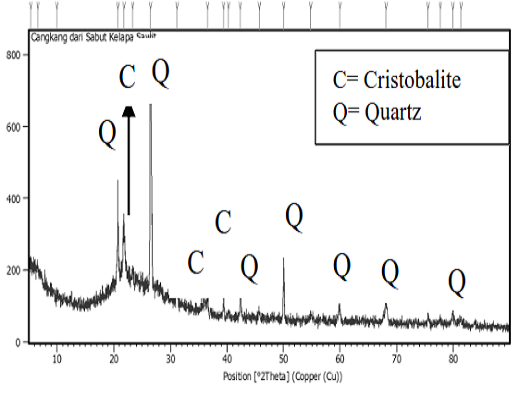Synthesis and Characterization of Silica Gel from Palm Shell and Coir Ash
Abstract
This study aims to determine the composition of the oxide, the characteristics of palm shell and coir, and silica gel synthesized. The oxide composition, crystallinity, palm shell and coir ash functional groups were analyzed using XRF, XRD, and FTIR. Analysis of the functional groups and crystallinity using FT-IR and XRD. The results showed the composition of SiO2 in palm shell and coir ash was 76%, and SiO2 in the form of quartz and cristobalite was more dominant than amorphous SiO2. The synthesis success was indicated by the appearance of peaks with low intensity, not sharp, and resembling bumps on the synthesized silica gel diffractogram, which is an amorphous SiO2 characteristic. This result is confirmed by FT-IR, where absorption at wave number 455 cm-1 is a Si-O-Si bending vibration, 783 cm-1 is a stretching vibration of Si-O symmetry of Si-O-Si, 3454.51 cm-1, and 3568 cm-1 with fairly high intensity are characteristic of the -OH group from Si-OH. The wide and sharp absorption at 1083.99 cm-1 is a stretching vibration of the Si-O symmetry of Si-O-Si, 1625.99 cm-1 is -OH vibration of water molecule, 798.53 cm-1 is Si-O stretching vibration of Si-O-Si and absorption of 462.92 cm-1 indicates bending vibration of Si-O-Si.
Downloads

Copyright (c) 2023 Sunarti Sunarti, Abraham Mariwy, Asasa N. Laitupa

This work is licensed under a Creative Commons Attribution-NonCommercial-NoDerivatives 4.0 International License.
Authors who publish with this journal agree to the following terms:
- Copyright on any article is retained by the author(s).
- The author grants the journal, the right of first publication with the work simultaneously licensed under a Creative Commons Attribution License that allows others to share the work with an acknowledgment of the work’s authorship and initial publication in this journal.
- Authors are able to enter into separate, additional contractual arrangements for the non-exclusive distribution of the journal’s published version of the work (e.g., post it to an institutional repository or publish it in a book), with an acknowledgment of its initial publication in this journal.
- Authors are permitted and encouraged to post their work online (e.g., in institutional repositories or on their website) prior to and during the submission process, as it can lead to productive exchanges, as well as earlier and greater citation of published work.
- The article and any associated published material is distributed under the Creative Commons Attribution-NonCommercial-NoDerivatives 4.0 International License.





_copy1.png)










